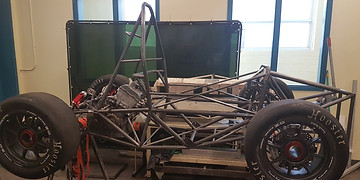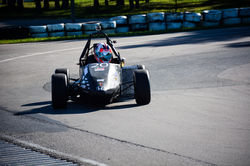Muhammad Arham
What is Formula SAE?
"Formula SAE is a competition organized by the Society of Automotive Engineers. The competition is open to engineering faculties worldwide and consists of the design, construction, and testing of an open wheeled race car. The cars are constructed according to engine and frame limitations that promote engineering creativity. All cars must pass through a 96 point technical inspection before being allowed to compete. The cars are built over a time period of one school year and are taken to several competitions each year with over 150 schools from 13 countries participating. FSAE provides valuable real world experience that can be directly applied in the automotive, as well as other, engineering sectors in post graduate pursuits" - www.qfsae.ca
For more Queen's Formula content and media, visit: www.qfsae.ca
What is Queen's Formula?
My Formula Experience


Being so heavily involved in a Formula SAE design team has made me a much better engineer. My time on Queen's Formula has allowed me to learn and develop real world engineering skills that can't be taught in a classroom. From soft skills like project management, marketing, media management, effective communication, leadership and teamwork, to more technical skills such as design software packages (CAD, FEA, CFD etc) and real hands-on manufacturing (CNC/manual machining, welding, and pretty much anything else you can imagine).
Working under pressure in a setting with real life consequences forces you to develop a very good eye for detail and excellent problem solving skills. Mistakes cost time and money in Formula. In an 8 month season, getting the vehicle finished and ready for testing as soon as possible is imperative, the more testing time there is, the more fine tuning you can do to produce a well performing and reliable car. There is a direct relationship between amount of testing time and placement in competition. At Queen’s Formula all team members are responsible for procuring funding and resources for the team, which means we work with a very limited budget, and a mistake can cost a lot of money, or even a race season. This forces us to push the envelope of time efficient design and manufacturing without ever compromising design/build quality to produce the best vehicle we can in as short of a time span as possible.
Chassis Development



As the Chassis Lead for Queen's Formula, I am in charge of the design and fabrication of a lightweight, high stiffness space-frame chassis for a Formula SAE open-wheeled race car. My responsibilities include making a 3D CAD model and ensuring it adheres to the competition rules/regulations, using FEA software packages to perform structural analyses and simulations on the design to ensure it will be safe and strong while harmoniously integrating all other subsystems of the vehicle (ie powertrain, steering, suspension etc).
Building the frame is my next challenge, precision is very important for a high performance vehicles. I enforce a maximum tolerance of under 1 mm and 0.1 degrees for chassis construction for maximum accuracy so the chassis behaves exactly as it was designed to and to ensure physical test results replicate simulations for design validation. Once the frame is built, a series of physical tests matching the simulations is conducted on a torsion table to determine the frames torsional rigidity and stiffness under different loading scenarios. The gathered data from the physical tests is then compared to the simulations. I am also researching sub-frames, carbon fiber monocoques and their implementation feasibility.
Q17


The design goals of the of the Q17 chassis were centred around iproving driver ergonomics, serviceability, and ease of manufacturing without compromising stiffness and weight. The chassis is a 4130 CNC profiled spaceframe, constructed in-house. Manufacturing time was reduced by replacing multiple mitred tubes with single bent tubes, lowering the total number of tubes from 93 to 81. Improved driver ergonomics were targeted by lowering the shoulder bars, increasing elbow room and expanding the pedal box. The 2017 chassis saw a 24% stiffness increase compared to the previous year’s chassis and was only 4% heavier, with improved driver comfort, a 40% average reduction in driver egress time, and was finished 2 months earlier. With more testing time to tune and refine the car, we finished with an overall ranking of 46/109 in Michigan FSAE, compared to 79/115 in 2016.
The chassis focus for the 2018 year was to increase torsional rigidity and reduce compliance in components and chassis systems without compromising weight. Experimental design techniques such as topology optimization were used to provide insight into optimal frame configuration. Emphasis was put on validating design choices with both simulations/models and physical testing.
Q18
Formula Gallery
 |  |  |  |  |
|---|---|---|---|---|
 |  |  |  |  |
 |  |  |  |  |
 |  |  |  |  |
 |  |  |  |  |
 |  |  |  |  |
